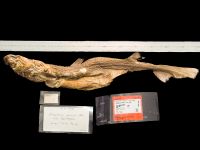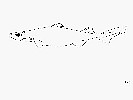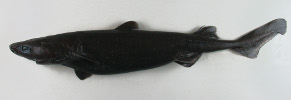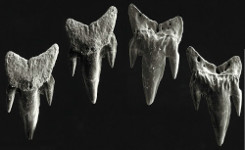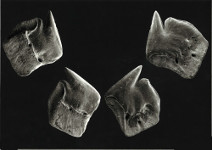Etmopterus princeps
Collett, 1904
Great lanternshark
Classification: Elasmobranchii Squaliformes Etmopteridae
Reference of the original description
Diagnoses of four hitherto undescribed fishes from the depths south of the Faroe Islands. Forhandlinger i Videnskabs–selskabet i Christiania, 1904, 9, 1–7
Diagnoses of four hitherto undescribed fishes from the depths south of the Faroe Islands. Forhandlinger i Videnskabs–selskabet i Christiania, 1904, 9, 1–7
Synonyms / new combinations and misspellings
Spinax princeps
Spinax princeps
Description :
Citation: Etmopterus princeps Collett, 1904: In: Database of modern sharks, rays and chimaeras, www.shark-references.com, World Wide Web electronic publication, Version 01/2026
Please send your images of "Etmopterus princeps" to info@shark-references.com

Etmopterus princeps Collett, 1904 © Samuel P. Iglésias, Muséum national d’Histoire naturelle, Département Milieux et Peuplements Aquatiques Chondrichthyans from the North-eastern Atlantic and the Mediterranean

Etmopterus princeps Collett, 1904 © Samuel P. Iglésias, Muséum national d’Histoire naturelle, Département Milieux et Peuplements Aquatiques Chondrichthyans from the North-eastern Atlantic and the Mediterranean
Common names
 Großer Laternenhai,
Großer Laternenhai,  Großer schwarzer Dornhai,
Großer schwarzer Dornhai,  Tollo lucero,
Tollo lucero,  Tollo lucero raspa,
Tollo lucero raspa,  Sagre rude,
Sagre rude,  Great lantern shark,
Great lantern shark,  Great lanternshark
Great lanternshark
 Großer Laternenhai,
Großer Laternenhai,  Großer schwarzer Dornhai,
Großer schwarzer Dornhai,  Tollo lucero,
Tollo lucero,  Tollo lucero raspa,
Tollo lucero raspa,  Sagre rude,
Sagre rude,  Great lantern shark,
Great lantern shark,  Great lanternshark
Great lanternshark
Short Description
Field marks and Diagnostic Features after EBERT & STEHMANN, 2013 [17836]: A very large, heavy–bodied, broad–headed, short–tailed, uniform–coloured, blackish lanternshark with a short thick flat snout. Upper teeth with a cusp and one or more pairs of cusplets, lower teeth compressed, knife–like, and with a cusp and blade. Lateral trunk denticles wide–spaced and moderately large, with stout cusps, giving the body a rough texture, forming inconspicuous, regular longitudinal rows on caudal peduncle and caudal–fin base. Two dorsal fins with fin spines, first dorsal fin smaller than second dorsal fin, second dorsal–fin spine recurved and pointing posterodorsally in adults. No anal fin. Discrete photomarks absent. Diagnostic Features: Head fairly deep but not conical; head relatively long, 19 to 25% of total length and 2.4 to 3.0 times in snout–vent length; head width about 1.5 to 1.6 times preoral snout; head low, height 10 to 12% of total length. Prespiracular length 1.6 to 1.7 times spiracle–pectoral space. Snout flattened and semibulbous, not conical; preoral length short and about 9 to 10% of total length. Eyes narrow and elongated; upper eyelid apparently without a pale naked patch. Gill openings much wider than spiracle; width of third gill opening about a third to half eye length. Mouth relatively broad and 1.4 to 1.7 times eye length. Total tooth row counts upper jaw 29 to 32, lower jaw 40 to 50. Upper teeth generally with one or two pairs of cusplets, cusps moderately expanded and about 1.5 to 3 times higher than adjacent cusplets; upper teeth of mature males large with a cusp and a pair of long cusplets. Body moderately firm, cylindrical, and stout. Predorsal spine length about 33 to 37% of total length; interdorsal space usually greater than prebranchial length, slightly shorter to slightly longer than head length; pectoral–pelvic space about 1.3 to 1.5 times head length in adults; snout tip to rear flank marking base not comparable to snout tip to second dorsal spine origin; dorso–caudal space 8.6 to 9.8% of total length and about 2.0 to 2.6 in interdorsal space; pelvic–caudal space 12 to 15% of total length, about 1.2 to 1.7 times first dorsal–fin length, 1.4 to 1.8 in interdorsal space, subequal to or slightly greater than prespiracular space and less than or subequal to prebranchial length, and 1.7 to 2.4 times in pectoral–pelvic space. No rows of greatly enlarged denticles on flanks above pectoral fins; denticles largely covering underside of snout, except for naked areas at lips and sometimes in the midline of the snout; denticles not in regular longitudinal rows on head and flanks but with linear denticles on caudal peduncle and base of caudal fin; denticles present on second dorsal fin, mostly covering it except for outer margin of fin web; lateral trunk denticles short, robust, wide–spaced, and with stout, hooked conical crowns. Distal margins of fins not fringed with naked ceratotrichia. Pectoral fin small with anterior margin length about 8.0 to 8.9% of total length, broadly rounded or rounded–angular in shape. First dorsal–fin origin behind pectoral–fin free rear tips, base somewhat closer to pectoral–fin bases than pelvic fins; first dorsal–fin spine stout, short, and usually lower than first dorsal–fin apex, spine origin nearer to snout tip than upper caudal–fin origin. Second dorsal fin much larger than first but less than twice its area, height 32 to 40% of second dorsal–fin length, apex more or less pointed or rounded angular, and posterior margin nearly straight to deeply concave; second dorsal–fin spine stout and recurved, with its tip diagonally vertical in adults. Dorsal caudal–fin margin about equal to head length. Vertebral counts: total vertebral counts 81 to 86, precaudal vertebral counts 58 to 60, monospondylous vertebral counts 44 to 47. Size large with adults to about 89 cm. Colour: black or blackish–brown on dorsal surface, underside of snout, abdomen and tail blackish, dorsal and ventral surfaces dark, ventral surface not conspicuously darker than dorsal surfaces; fins dark distally, except second dorsal rear tip which is sometimes lighter, no conspicuous dark bands on caudal fin; no light pineal blotch on dorsal surface of head. No photolines on body. Suprapelvic black bar absent. Flank photomarks absent. Ventral saddle–shaped precaudal photomark absent from caudal peduncle. Caudal photomarks absent.
Field marks and Diagnostic Features after EBERT & STEHMANN, 2013 [17836]: A very large, heavy–bodied, broad–headed, short–tailed, uniform–coloured, blackish lanternshark with a short thick flat snout. Upper teeth with a cusp and one or more pairs of cusplets, lower teeth compressed, knife–like, and with a cusp and blade. Lateral trunk denticles wide–spaced and moderately large, with stout cusps, giving the body a rough texture, forming inconspicuous, regular longitudinal rows on caudal peduncle and caudal–fin base. Two dorsal fins with fin spines, first dorsal fin smaller than second dorsal fin, second dorsal–fin spine recurved and pointing posterodorsally in adults. No anal fin. Discrete photomarks absent. Diagnostic Features: Head fairly deep but not conical; head relatively long, 19 to 25% of total length and 2.4 to 3.0 times in snout–vent length; head width about 1.5 to 1.6 times preoral snout; head low, height 10 to 12% of total length. Prespiracular length 1.6 to 1.7 times spiracle–pectoral space. Snout flattened and semibulbous, not conical; preoral length short and about 9 to 10% of total length. Eyes narrow and elongated; upper eyelid apparently without a pale naked patch. Gill openings much wider than spiracle; width of third gill opening about a third to half eye length. Mouth relatively broad and 1.4 to 1.7 times eye length. Total tooth row counts upper jaw 29 to 32, lower jaw 40 to 50. Upper teeth generally with one or two pairs of cusplets, cusps moderately expanded and about 1.5 to 3 times higher than adjacent cusplets; upper teeth of mature males large with a cusp and a pair of long cusplets. Body moderately firm, cylindrical, and stout. Predorsal spine length about 33 to 37% of total length; interdorsal space usually greater than prebranchial length, slightly shorter to slightly longer than head length; pectoral–pelvic space about 1.3 to 1.5 times head length in adults; snout tip to rear flank marking base not comparable to snout tip to second dorsal spine origin; dorso–caudal space 8.6 to 9.8% of total length and about 2.0 to 2.6 in interdorsal space; pelvic–caudal space 12 to 15% of total length, about 1.2 to 1.7 times first dorsal–fin length, 1.4 to 1.8 in interdorsal space, subequal to or slightly greater than prespiracular space and less than or subequal to prebranchial length, and 1.7 to 2.4 times in pectoral–pelvic space. No rows of greatly enlarged denticles on flanks above pectoral fins; denticles largely covering underside of snout, except for naked areas at lips and sometimes in the midline of the snout; denticles not in regular longitudinal rows on head and flanks but with linear denticles on caudal peduncle and base of caudal fin; denticles present on second dorsal fin, mostly covering it except for outer margin of fin web; lateral trunk denticles short, robust, wide–spaced, and with stout, hooked conical crowns. Distal margins of fins not fringed with naked ceratotrichia. Pectoral fin small with anterior margin length about 8.0 to 8.9% of total length, broadly rounded or rounded–angular in shape. First dorsal–fin origin behind pectoral–fin free rear tips, base somewhat closer to pectoral–fin bases than pelvic fins; first dorsal–fin spine stout, short, and usually lower than first dorsal–fin apex, spine origin nearer to snout tip than upper caudal–fin origin. Second dorsal fin much larger than first but less than twice its area, height 32 to 40% of second dorsal–fin length, apex more or less pointed or rounded angular, and posterior margin nearly straight to deeply concave; second dorsal–fin spine stout and recurved, with its tip diagonally vertical in adults. Dorsal caudal–fin margin about equal to head length. Vertebral counts: total vertebral counts 81 to 86, precaudal vertebral counts 58 to 60, monospondylous vertebral counts 44 to 47. Size large with adults to about 89 cm. Colour: black or blackish–brown on dorsal surface, underside of snout, abdomen and tail blackish, dorsal and ventral surfaces dark, ventral surface not conspicuously darker than dorsal surfaces; fins dark distally, except second dorsal rear tip which is sometimes lighter, no conspicuous dark bands on caudal fin; no light pineal blotch on dorsal surface of head. No photolines on body. Suprapelvic black bar absent. Flank photomarks absent. Ventral saddle–shaped precaudal photomark absent from caudal peduncle. Caudal photomarks absent.
Distribution
Northwest Atlantic: Nova Scotia, Canada to New Jersey, USA. Northeast Atlantic: southern Iceland along Atlantic slope to Faeroes, Hebrides, UK, English Channel, Bay of Biscay and Gibraltar, Mauritania. Nominally recorded from New Caledonia in the Western Central Pacific, but its status there needs clarification - other large species of lanternsharks (Etmopterus baxteri and Etmopterus unicolor) may be involved [544]. Source: www.gbif.org
Northwest Atlantic: Nova Scotia, Canada to New Jersey, USA. Northeast Atlantic: southern Iceland along Atlantic slope to Faeroes, Hebrides, UK, English Channel, Bay of Biscay and Gibraltar, Mauritania. Nominally recorded from New Caledonia in the Western Central Pacific, but its status there needs clarification - other large species of lanternsharks (Etmopterus baxteri and Etmopterus unicolor) may be involved [544]. Source: www.gbif.org
Human uses
fisheries: of no interest
fisheries: of no interest
Dentition
Teeth smooth edged; 32/50 in adult male of 545 mm.; 30/40 male of 404 mm, 29/48 in female of 593 mm; a range suggesting that the number tends to increase with growth; the lower jaw with or without a median tooth. Upper teeth mostly with 5 cusps in adults, the median cusp much the largest, the outermost much the smallest; those of middle sized specimens either with the outer pair of cusps minute, or with only 3 cusps; small specimens with 3 cusps only. Lower teeth with cusps directed outward at an angle of as much as 70-75° in some cases, in others almost parallel with jaw, the inner margins of successive teeth together forming a nearly continuous cutting edge ; those toward corners of jaws much smaller than those along central part. [2749]
Links: SEM-images of teeth
Teeth smooth edged; 32/50 in adult male of 545 mm.; 30/40 male of 404 mm, 29/48 in female of 593 mm; a range suggesting that the number tends to increase with growth; the lower jaw with or without a median tooth. Upper teeth mostly with 5 cusps in adults, the median cusp much the largest, the outermost much the smallest; those of middle sized specimens either with the outer pair of cusps minute, or with only 3 cusps; small specimens with 3 cusps only. Lower teeth with cusps directed outward at an angle of as much as 70-75° in some cases, in others almost parallel with jaw, the inner margins of successive teeth together forming a nearly continuous cutting edge ; those toward corners of jaws much smaller than those along central part. [2749]
Links: SEM-images of teeth
Remarks
shark-references Species-ID=2182; Links: digital version of the original description: COLLETT, R. 1904: Diagnoses of four hitherto undescribed fishes from the depths south of the Faroe Islands. Forhandlinger i Videnskabs-selskabet i Christiania (for 1904), 9: 1-7"
shark-references Species-ID=2182; Links: digital version of the original description: COLLETT, R. 1904: Diagnoses of four hitherto undescribed fishes from the depths south of the Faroe Islands. Forhandlinger i Videnskabs-selskabet i Christiania (for 1904), 9: 1-7"
Parasites (arranged by Jürgen Pollerspöck)
Monogenea
Cestoda
Copepoda
Thecostraca
Monogenea
- Asthenocotyle azorensis Kearn, Whittington & Thomas, 2012 [17325]
- Asthenocotyle kaikourensis Robinson, 1961 [17325]
- Asthenocotyle taranakiensis Beverley-Burton, Klassen & Lester, 1987 [17325]
Cestoda
Copepoda
Thecostraca
- Anelasma sp. [6891]








